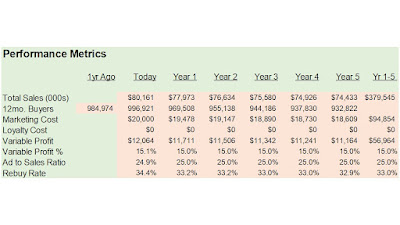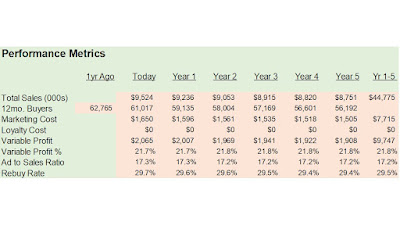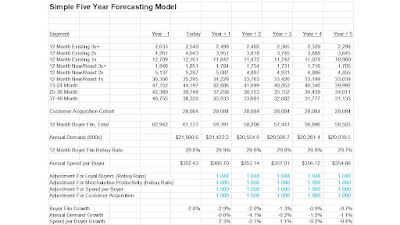When people talk about email marketing, you get an "industry" view of the craft. A style of language has been crafted so that professionals are speaking via common terms that everybody can understand.
This means you measure results via opens/clicks/conversions.
What would happen if you stopped your email marketing program altogether?
What would happen if you didn't execute your email marketing program for five years?
Well, when you have a simulation tool, you can answer that question.
Here is our base case for the brand we studied this week.
Aaaaand .... here's what the five year forecast looks like if we stopped email marketing altogether.Holy cow!Here's what sales look like by year with email marketing (000s).
- $9,524 today.
- $9,236 after 1 year.
- $9,053 after 2 years.
- $8,915 after 3 years.
- $8,820 after 4 years.
- $8,751 after 5 years.
Here's what sales look like without email marketing. Tell me what you observe.
- $9,524 today.
- $7,566 after 1 year.
- $7,028 after 2 years.
- $6,643 after 3 years.
- $6,417 after 4 years.
- $6,253 after 5 years.
Yes, the impact compounds. When you remove an email order, you remove future orders in other marketing channels. You weaken the customer, and consequently you weaken file power, hurting future sales.
Let's look at profit by year. With email marketing.
- $2,065 today.
- $2,007 after 1 year.
- $1,969 after 2 years.
- $1,941 after 3 years.
- $1,922 after 4 years.
- $1,908 after 5 years.
What happens if we remove email marketing?
- $2,065 today.
- $1,487 after 1 year.
- $1,398 after 2 years.
- $1,338 after 3 years.
- $1,302 after 4 years.
- $1,275 after 5 years.
Oh my goodness.
By the time five years have passed without email marketing, variable profit is down 34%. After you subtract fixed costs (about a million a year), you barely have any profit left!
What happened to rebuy rates? After five years:
- With Email Marketing = 29.4%.
- Without Email Marketing = 21.3%.
So yeah, email marketing is kinda important, don't you think?
When somebody at your company sleeps through your 2022 email marketing program, WAKE 'EM UP! Show them the results of your simulation applications, and show them that without you your company is gonna struggle. Ask them to pay attention! You matter.























